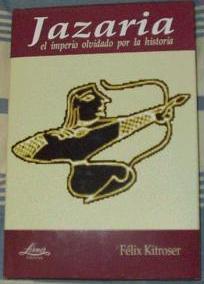 This Spanish-language book, by the prolific Argentinian writer
Félix Kitroser (1914-2009) in collaboration with the American historian Kevin Brook, presents the
full history of the Khazars, a Turkic people who founded a
large empire in eastern Europe in the early Middle Ages. Khazaria was an
economic and cultural superpower which was connected to several important
trade routes and was one of the largest-sized political formations of its
time. Khazaria was the only nation in its region with a permanent
standing army. It was also notable for its religious tolerance and its
supreme court which had judges representing multiple religions.
This Spanish-language book, by the prolific Argentinian writer
Félix Kitroser (1914-2009) in collaboration with the American historian Kevin Brook, presents the
full history of the Khazars, a Turkic people who founded a
large empire in eastern Europe in the early Middle Ages. Khazaria was an
economic and cultural superpower which was connected to several important
trade routes and was one of the largest-sized political formations of its
time. Khazaria was the only nation in its region with a permanent
standing army. It was also notable for its religious tolerance and its
supreme court which had judges representing multiple religions.
In the 9th century, many of the Khazars converted to Judaism. Jewish life flourished in the Khazar towns of Atil, Samandar, Samkarsh, Kerch, Sudak, Kiev, and Sarkel. It is possible that descendants of the Khazars can be found among some Ashkenazi Jews, Kumyks, Szekelys, and other groups.
The fascinating history of the Khazars has been studied by many historians and archaeologists in recent years. International scholarly conferences on the Khazars have been held in Israel (1999) and Russia (2002) and much new research has been published from new investigations and archaeological discoveries. There has also been much interest among the general public. Novels about the Khazars by Milorad Pavic, Meir Uziel, and Marek Halter have become bestsellers. Ehud Yaari's television documentary about the Khazars was very popular in Israel. The Khazars have been discussed in major international media including La Nación (Argentina), Le Monde and Sciences et Avenir (France), and the Jerusalem Report and Ma'ariv (Israel).
Kitroser presents the latest discoveries and theories about Khazaria in an easy-to-understand way. The book includes color maps of Khazaria by Richard Burd and many illustrations of Khazar artifacts - including the Moses Jewish Khazar Coin found in Gotland in 2002. It also contains translations of the letters exchanged between King Joseph of Khazaria and Hasdai ibn Shaprut, a diplomat of the caliphate of Cordoba in Spain, and of the Schechter Letter, an account of Khazar history and politics by an anonymous Khazarian Jew.
En el siglo IX, buena parte de la población de Jazaria se convirtió al Judaísmo. La vida judía floreció en las ciudades Jázaras de Atil, Samandar, Samkarsh, Kerch, Sudak, Kiev y Sarkel, y es posible que puedan encontrarse descendientes de los Jázaros entre algunos Judíos Askenazis, Kumyks, Szekelis y otros grupos humanos actuales.
La fascinante historia de los Jázaros ha sido recientemente estudiada por numerosos historiadores y arqueólogos. Se han realizado conferencias internacionales en Israel (1999) y Rusia (2002) y se han publicado muchos de los resultados de las nuevas investigaciones y descrubrimientos arqueológicos. El tema ha despertado, además, gran interés entre el público en general. Varios escritores han publicado novelas sobre los Jázaros, que se convirtieron en "best sellers" como las de Milorad Pavich, Meir Uziel y Marek Halter. La serie documentaria televisiva de Ehud Yaari sobre los Jázaros fue muy popular en Israel. La historia de Jazaria ha sido discutida en los mejores periódicos internacionales, incluyendo el periódico La Nación (Argentina), Le Monde y Sciences et Avenir (Francia), Jerusalem Report y Ma'ariv (Israel), entre otros.
Este libro contiene informes de los últimos descubrimientos arqueológicos, ilustraciones de productos de Jazaria y las traducciones de la correspondencia entre el rey José de Jazaria y el canciller del califato de Andalucía, Hasdai ibn Shaprut. Presenta, además, los mapas de Jazaria diseñados por el geógrafo norteamericano Richard Burd. Es, sin duda, una buena introducción para el conocimiento de este pueblo fascinante y en un tiempo, enigmático.
I'm not currently selling copies and I'm not aware of others who have copies for sale at the moment.